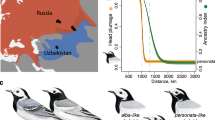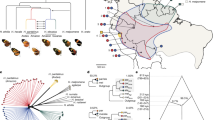Abstract
The evolution of genetic barriers opposing interspecific gene flow is key to the origin of new species. Drawing from information on over 400 admixed genomes sourced from replicate transects across the European hybrid zone between all-black carrion crows and grey-coated hooded crows, we decipher the interplay between phenotypic divergence and selection at the molecular level. Over 68% of plumage variation was explained by epistasis between the gene NDP and a ~2.8-megabase region on chromosome 18 with suppressed recombination. Both pigmentation loci showed evidence for divergent selection resisting introgression. This study reveals how few, large-effect loci can govern prezygotic isolation and shield phenotypic divergence from gene flow.
This is a preview of subscription content, access via your institution
Access options
Access Nature and 54 other Nature Portfolio journals
Get Nature+, our best-value online-access subscription
$29.99 / 30 days
cancel any time
Subscribe to this journal
Receive 12 digital issues and online access to articles
$119.00 per year
only $9.92 per issue
Buy this article
- Purchase on Springer Link
- Instant access to full article PDF
Prices may be subject to local taxes which are calculated during checkout


Similar content being viewed by others
References
Wolf, J. B. W. & Ellegren, H. Nat. Rev. Genet. 18, 87–100 (2017).
Ravinet, M. et al. J. Evol. Biol. 30, 1450–1477 (2017).
Vijay, N. et al. Nat. Commun. 7, e13195 (2016).
Mayr, E. Systematics and the Origin of Species (Columbia Univ. Press, 1942).
Randler, C. Ardea 95, 143–149 (2007).
Saino, N. & Scatizzi, L. Boll. Zool. 58, 255–260 (1991).
Londei, T. Ibis 155, 632–634 (2013).
Poelstra, J. W. et al. Science 344, 1410–1414 (2014).
Poelstra, J. W., Vijay, N., Hoeppner, M. P. & Wolf, J. B. W. Mol. Ecol. 24, 4617–4628 (2015).
Le Corre, V. & Kremer, A. Mol. Ecol. 21, 1548–1566 (2012).
Gompert, Z., Mandeville, E. G. & Buerkle, C. A. Annu. Rev. Ecol. Evol. Syst. 48, 207–229 (2017).
Barton, N. H. & Hewitt, G. M. Annu. Rev. Ecol. Syst. 16, 113–148 (1985).
Wu, C. C. et al. In situ quantification of individual mRNA transcripts in melanocytes discloses gene regulation of relevance to speciation. J. Exp. Biol. https://doi.org/10.1242/jeb.194431 (2019).
Ke, J. Y. et al. Gene Dev. 27, 2305–2319 (2013).
Vickrey, A. I. et al. eLife 7, e34803 (2018).
Haas, F. et al. Mol. Ecol. 18, 294–305 (2009).
Szymura, J. M. & Barton, N. H. Evolution 40, 1141–1159 (1986).
Weissensteiner, M. H. et al. Genome Res. 27, 697–708 (2017).
Kofron, M. et al. Dev. Biol. 237, 183–201 (2001).
Duquet, M. Ornithos 19, 57–67 (2012).
Rolando, A. Ornis Scand. 24, 80–83 (1993).
Mackay, T. F. C. Nat. Rev. Genet. 15, 22–33 (2014).
Pennisi, E. Science 345, 611–613 (2014).
Nadeau, N. J. et al. Genome Res. 24, 1316–1333 (2014).
Toews, D. P. L. et al. Curr. Biol. 26, 2313–2318 (2016).
Brodin, A. & Haas, F. Anim. Behav. 72, 139–146 (2006).
Brodin, A. & Haas, F. Evol. Ecol. 23, 17–29 (2009).
Saino, N. & Villa, S. Auk 109, 543–555 (1992).
Seehausen, O. et al. Nature 455, 620–626 (2008).
Coyne, J. A. & Orr, H. A. Evolution 51, 295–303 (1997).
Untergasser, A. et al. Nucleic Acids Res. 40, e115 (2012).
DePristo, M. A. et al. Nat. Genet. 43, 491–498 (2011).
Gompert, Z. & Buerkle, C. A. Mol. Ecol. Resour. 10, 378–384 (2010).
R Development Core Team R: a Language and Environment for Statistical Computing (R Foundation for Statistical Computing, 2017).
Anderson, E. C. & Thompson, E. A. Genetics 160, 1217–1229 (2002).
Wringe, B. F., Stanley, R. R. E., Jeffery, N. W., Anderson, E. C. & Bradbury, I. R. Mol. Ecol. Resour. 17, 91–95 (2017).
Vähä, J. P. & Primmer, C. R. Mol. Ecol. 15, 63–72 (2006).
Wringe, B. F., Stanley, R. R. E., Jeffery, N. W., Anderson, E. C. & Bradbury, I. R. Mol. Ecol. Resour. 17, e275–e284 (2017).
Nielsen, E. E., Bach, L. A. & Kotlicki, P. Mol. Ecol. Notes 6, 971–973 (2006).
Josse, J. & Husson, F. J. Stat. Softw. 70, 1–31 (2016).
Lê, S., Josse, J. & Husson, F. J. Stat. Softw. 25, 1–18 (2008).
Stoffel, M. A., Nakagawa, S. & Schielzeth, H. Methods Ecol. Evol. 8, 1639–1644 (2017).
Aulchenko, Y. S., Ripke, S., Isaacs, A. & Van Duijn, C. M. Bioinformatics 23, 1294–1296 (2007).
Gao, X. Y., Stamier, J. & Martin, E. R. Genet. Epidemiol. 32, 361–369 (2008).
Burnham, K. P. & Anderson, D. R. Model Selection and Multimodel Inference 2nd edn (Springer, 1998).
Lynch, M. & Walsh, B. Genetics and Analysis of Quantitative Traits (Sinauer, 1998).
Derryberry, E. P., Derryberry, G. E., Maley, J. M. & Brumfield, R. T. Mol. Ecol. Resour. 14, 652–663 (2014).
Szymura, J. M. & Barton, N. H. Evolution 45, 237–261 (1991).
Metropolis, N., Rosenbluth, A. W., Rosenbluth, M. N., Teller, A. H. & Teller, E. J. Chem. Phys. 21, 1087–1092 (1953).
Hastings, W. K. Biometrika 57, 97–109 (1970).
Bailey, R. gghybrid: Evolutionary analysis of hybrids and hybrid zones. R package version 0.0.0.9000 (2018).
Gompert, Z. & Buerkle, C. A. Mol. Ecol. Resour. 12, 1168–1176 (2012).
Buerkle, C. A. Mol. Ecol. Notes 5, 684–687 (2005).
Fitzpatrick, B. M. Ecol. Evol. 3, 1951–1966 (2013).
Sung, C. J., Bell, K. L., Nice, C. C. & Martin, N. H. Mol. Ecol. 27, 959–978 (2018).
Purcell, S. et al. Am. J. Hum. Genet. 81, 559–575 (2007).
Goude, J. & Jombart, T. hierfstat: Estimation and tests of hierarchical F-statistics. R package version 0.04-22 (2015).
Ma, J. Z. & Amos, C. I. PLoS ONE 7, e40224 (2012).
Knief, U. et al. Genome Biol. 17, e199 (2016).
Duforet-Frebourg, N., Luu, K., Laval, G., Bazin, E. & Blum, M. G. B. Mol. Biol. Evol. 33, 1082–1093 (2016).
Zheng, X. W. et al. Bioinformatics 28, 3326–3328 (2012).
Acknowledgements
This study would not have been possible without the commitment of dedicated ornithologists who helped to locate active nest sites and participated in sampling. These include M. Hug and colleagues in Brandenburg, J. Voigt, D. Kronbach, J. Wollmerstädt, M. Schrack and W. Nachtigall in Sachsen, M. Döpfner in Baden-Württemberg, S. Zinko and M. Grossmann in Austria, and personnel of the Amministrazione Provinciale of Alessandria, Asti and Cuneo in Italy. We further acknowledge the Max Planck Institute for Ornithology in Radolfzell, the Friedrich-Löffler-Institute and the Förderverein Sächsische Vogelschutzwarte Neschwitz e. V. for help with the organization of field work. The UPPMAX Next-Generation Sequencing Cluster and Storage (UPPNEX) project, funded by the Knut and Alice Wallenberg Foundation and Swedish National Infrastructure for Computing, provided access to computational resources. Funding was provided by the VolkswagenStiftung (grant I/83 496 to J.B.W.W.), European Research Council (ERCStG-336536 FuncSpecGen to J.B.W.W.), Knut and Alice Wallenberg Foundation (project grant including J.B.W.W.) and LMU Munich (to J.B.W.W.).
Author information
Authors and Affiliations
Contributions
U.K., C.M.B. and J.B.W.W. conceived of the study design. C.M.B., J.P., M.W., B.H., N.S. and J.B.W.W. conducted the field work and provided samples. C.M.B. and U.K. performed all analyses. N.S. and J.P. helped with phenotype scoring, and N.V. assisted in SNP design. U.K., C.M.B. and J.B.W.W. wrote the manuscript with input from all other authors.
Corresponding author
Ethics declarations
Competing interests
The authors declare no competing interests.
Additional information
Publisher’s note: Springer Nature remains neutral with regard to jurisdictional claims in published maps and institutional affiliations.
Supplementary information
Supplementary Information
Supplementary Text, Supplementary Figures 1–15 and Supplementary Tables 2–7, 9, 12 and 13
Supplementary Table 1
List of SNP markers genotyped with the GoldenGate Assay (Illumina), their genomic location (genome version 2.5) and associated primer sequences.
Supplementary Table 8
Genotype and additional sampling data on all individuals (both GoldenGate Assay genotyping and GATK genotyping).
Supplementary Table 10
Phenotypic information on all individuals.
Supplementary Table 11
Information on the ancestral state of all SNPs.
Supplementary Code 1
Perform PCA on phenotypic data.
Supplementary Code 2
Prepare genotype data for NewHybrids and execute NewHybrids through R.
Supplementary Code 3
Estimate FIS and confidence intervals.
Supplementary Code 4
Convert genotype data to PLINK format, estimate FST and perform PCA on genotypes.
Supplementary Code 5
Estimate hybrid indices and fit geographic clines.
Supplementary Code 6
Estimate hybrid indices on subsets of SNPs and fit genomic clines.
Supplementary Code 7
Perform genome-wide association study and fit linear models with interactions between specific SNPs.
Rights and permissions
About this article
Cite this article
Knief, U., Bossu, C.M., Saino, N. et al. Epistatic mutations under divergent selection govern phenotypic variation in the crow hybrid zone. Nat Ecol Evol 3, 570–576 (2019). https://doi.org/10.1038/s41559-019-0847-9
Received:
Accepted:
Published:
Issue Date:
DOI: https://doi.org/10.1038/s41559-019-0847-9
This article is cited by
-
Mapping restricted introgression across the genomes of admixed indigenous African cattle breeds
Genetics Selection Evolution (2023)
-
A complex genomic architecture underlies reproductive isolation in a North American oriole hybrid zone
Communications Biology (2023)
-
Genomic architecture of phenotypic extremes in a wild cervid
BMC Genomics (2022)
-
Asymmetric introgression reveals the genetic architecture of a plumage trait
Nature Communications (2021)
-
From molecules to populations: appreciating and estimating recombination rate variation
Nature Reviews Genetics (2020)



